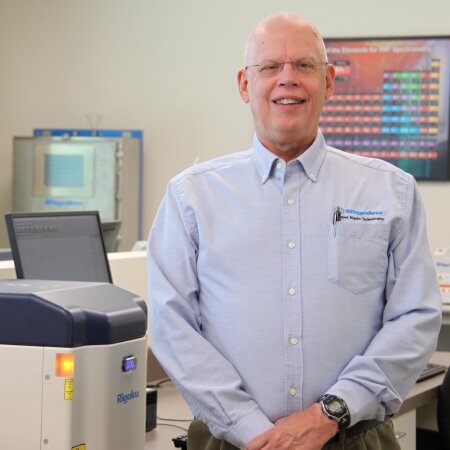Application Note EDXRF3144

Scope
This application note demonstrates the measurement of additive elements in new, fresh lubricating oils by ASTM D7751 using NEX CG II. Utilizing indirect excitation EDXRF and user-friendly QuantEZ software, results are reported using empirical calibration and Fundamental Parameters with Matching Library.
Background
Lubricating oils are used in on-road and off-road engines, as well as in the lubrication of mechanical machinery, and are formulated specifically for each type of use. Various additives are blended in base oil to enhance lube oil performance and create the optimum lubricity properties desired for each situation. Controlling additive elements when blending new, fresh lube oils is vital to ensure optimum lubrication properties while minimizing production waste and product rejection.
To meet the industry needs, Rigaku offers NEX CG II in compliance with ASTM D7751 Standard Test Method for Additive Elements in Lubricating Oils by EDXRF Analysis. Simple, intuitive QuantEZ software provides operators with an excellent tool for quality control in blending various lube oil formulations.
Empirical calibration
Empirical calibrations were built using a suite of 23 commercially available calibration standards. The suite of calibration standards must be representative of the lube oil formulation to be analyzed. Empirical alpha corrections are then employed to automatically compensate for variations in X-ray absorption and enhancement effects within the sample. A summary of the empirical calibrations is shown here.
| Element | Concentration range (Mass %) |
| Mg | 0.025 – 0.400 |
| P | 0.010 – 0.350 |
| S | 0.050 – 1.500 |
| Cl | 0.0025 – 0.401 |
| Ca | 0.025 – 1.000 |
| Zn | 0.010 – 0.250 |
| Mo | 0.0005 – 0.050 |
Precision
A representative sample from the calibration suite was chosen to demonstrate typical instrument repeatability (precision). Ten repeat analyses of the sample were performed with the sample in a static position.
| Sample: 16 Units: Mass % |
|||
| Element | Standard value | Average value | Std. dev. |
| Mg | 0.0250 | 0.0240 | 0.0015 |
| P | 0.0470 | 0.0450 | 0.0006 |
| S | 0.5000 | 0.4910 | 0.0075 |
| Cl | 0.0024 | 0.0025 | 0.0001 |
| Ca | 0.6501 | 0.6580 | 0.0004 |
| Zn | 0.2301 | 0.2350 | 0.0010 |
| Mo | 0.0005 | 0.0006 | 0.0001 |
Rigaku RPF-SQX Fundamental Parameters (FP)
Rigaku RPF-SQX FP software estimates elemental concentration based on XRF theory called Fundamental Parameters (FP) without the need for any known standards. Rigaku Profile Fitting (RPF) automatically deconvolutes spectral peaks and models the sample matrix using fundamental XRF. Standardless semi-quant results are often used for screening, comparative measurements, failure analysis, and investigations of new formulations in R&D.
Rigaku user-defined Matching Library
The user can easily tune the results using a Matching Library by measuring one or more samples of the actual material with known elemental assay values. In blending operations, this is best done by creating a specific Matching Library for each family of lube oils using actual product assayed by ICP. For example, one Matching Library for engine oils using actual engine oil product with ICP numbers, another for gear oils based on one or more gear oil products, and another for marine oils using actual product.
| Example Matching Library Families | |
| Family | Standards to use in the Matching Library |
| Engine Oils | 1-10 actual engine oil products |
| Gear Oils | 1-3 actual gear oil products |
| Marine Oils | 1-2 actual marine oil products |
In this way, the XRF is tuned to the actual products and ICP referee numbers, allowing Rigaku RPF-SQX FP to reliably model variations in base oils and formulations to ensure optimum accuracy and high-quality data.
Results using FP with Matching Library
The following results show a typical engine oil with ICP assays measured using a Matching Library.
| Sample: Engine Oil Units: Mass % |
|||
| Element | Assay value | NEX CG II result | Stat. Err. |
| Mg | 0.2003 | 0.1940 | 0.0030 |
| P | 0.2200 | 0.2240 | 0.0003 |
| S | 0.7001 | 0.7090 | 0.0004 |
| Cl | 0.0502 | 0.0515 | <0.0001 |
| Ca | 0.6000 | 0.6030 | 0.0010 |
| Zn | 0.2500 | 0.2510 | 0.0002 |
| Mo | 0.0300 | 0.0295 | 0.0004 |
Conclusion
The Rigaku NEX CG II combines indirect excitation with secondary targets, polarization targets, and a high-performance SDD to yield the optimum performance for elemental analysis of lube oils. Measurement times can be adjusted based on the formulation being measured to optimize various groups of elements. Rigaku RPF-SQX Fundamental Parameters can also be used in association with Matching Libraries to encompass families of lubricants for optimum accuracy and control during blending. With simple, intuitive, yet powerful QuantEZ software, NEX CG II is an excellent tool for process and quality control in the manufacturing of lube oil formulations and blends, as well as R&D and other uses.

